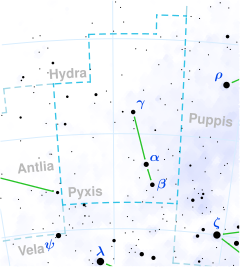Star in the constellation Pyxis
κ Pyxidis
Location of κ Pyxidis (circled)
Observation dataEpoch J2000 Equinox J2000
Constellation
Pyxis
Right ascension 09h 08m 02.88015s [ 1]
Declination
–25° 51′ 30.7331″[ 1]
Apparent magnitude (V)4.62[ 2]
Characteristics
Spectral type
K4III[ 3]
U−B color index
+1.87[ 4]
B−V color index
± 0.004[ 2]
Astrometry Radial velocity (Rv )± 2.8[ 5] km/s Proper motion (μ) RA: +34.771[ 1] mas /yr Dec.: +0.009[ 1] mas /yr Parallax (π)6.3116± 0.2408 mas [ 1] Distance 520 ± 20 ly pc ) Absolute magnitude (MV )−1.53[ 2] Details Radius +0.34 [ 1] R ☉ Luminosity ± 40[ 1] L ☉ Surface gravity (log g )± 0.22[ 6] cgs Temperature ± 31[ 6] K Metallicity [Fe/H] ± 0.08[ 6] dex Other designations κ Pyx , CPD −25°4067GC 12614HD 78541HIP 44824HR 3628SAO 177002PPM 255695CCDM J09080-2552ABWDS J09080-2552AB[ 7] Database references SIMBAD data
Kappa Pyxidis , Latinized from κ Pyxidis , is a single,[ 8] constellation of Pyxis . It is visible to the naked eye as a faint point of light with an apparent visual magnitude of +4.62.[ 2] light years from the Sun based on parallax , but is drifting closer with a radial velocity of −45 km/s[ 5] eccentricity of 0.68[ 2]
This is an aging giant with a stellar classification of K4III,[ 3] core then expanded and cooled. At present it has 67[ 1] radius of the Sun . It is a variable star of uncertain type, changing brightness with an amplitude of 0.0058 in visual magnitude over a period of 8.5 days.[ 9] luminosity of the Sun from its bloated photosphere at an effective temperature of 3,931 K.[ 6] visual companion is located at an angular separation of arcseconds [ 10]
References
^ a b c d e f g h Brown, A. G. A. ; et al. (Gaia collaboration ) (August 2018). "Gaia Data Release 2: Summary of the contents and survey properties" . Astronomy & Astrophysics 616 . A1. arXiv :1804.09365 Bibcode :2018A&A...616A...1G doi :10.1051/0004-6361/201833051 Gaia DR2 record for this source at VizieR .^ a b c d e Anderson, E.; Francis, Ch. (2012), "XHIP: An extended hipparcos compilation", Astronomy Letters , 38 (5): 331, arXiv :1108.4971 Bibcode :2012AstL...38..331A , doi :10.1134/S1063773712050015 , S2CID 119257644 . ^ a b Keenan, Philip C.; McNeil, Raymond C. (1989), "The Perkins Catalog of Revised MK Types for the Cooler Stars", The Astrophysical Journal Supplement Series , 71 : 245, Bibcode :1989ApJS...71..245K , doi :10.1086/191373 . ^ Johnson, H. L.; et al. (1966), "UBVRIJKL photometry of the bright stars", Communications of the Lunar and Planetary Laboratory , 4 (99): 99, Bibcode :1966CoLPL...4...99J . ^ a b de Bruijne, J. H. J.; Eilers, A.-C. (October 2012), "Radial velocities for the HIPPARCOS-Gaia Hundred-Thousand-Proper-Motion project", Astronomy & Astrophysics , 546 : 14, arXiv :1208.3048 Bibcode :2012A&A...546A..61D , doi :10.1051/0004-6361/201219219 , S2CID 59451347 , A61. ^ a b c d Prugniel, Ph.; et al. (July 2011), "The atmospheric parameters and spectral interpolator for the MILES stars", Astronomy & Astrophysics , 531 : A165, arXiv :1104.4952 Bibcode :2011A&A...531A.165P , doi :10.1051/0004-6361/201116769 , S2CID 54940439 . ^ "kap Pyx" . SIMBAD Centre de données astronomiques de Strasbourg . Retrieved 2019-09-14 .^ Eggleton, P. P.; Tokovinin, A. A. (2008), "A catalogue of multiplicity among bright stellar systems", Monthly Notices of the Royal Astronomical Society , 389 (2): 869, arXiv :0806.2878 Bibcode :2008MNRAS.389..869E , doi :10.1111/j.1365-2966.2008.13596.x S2CID 14878976 . ^ Koen, Chris; Eyer, Laurent (2002), "New periodic variables from the Hipparcos epoch photometry", Monthly Notices of the Royal Astronomical Society , 331 (1): 45– 59, arXiv :astro-ph/0112194 Bibcode :2002MNRAS.331...45K , doi :10.1046/j.1365-8711.2002.05150.x S2CID 10505995 . ^ Privett, Grant; Jones, Kevin (2013), The Constellation Observing Atlas Bibcode :2013coa..book.....P , ISBN 9781461476481














